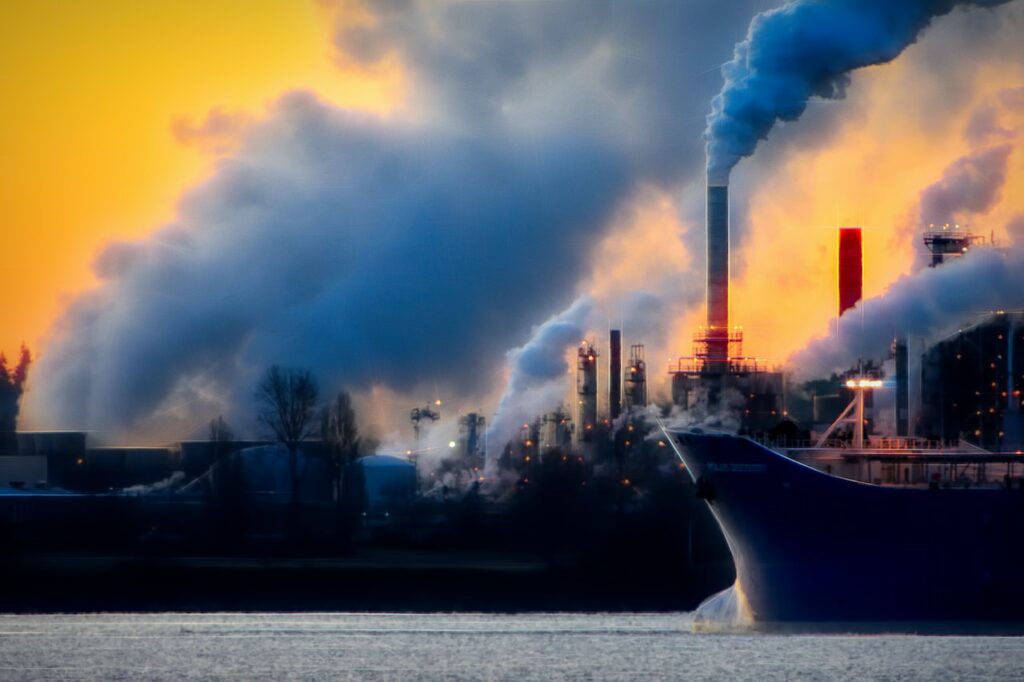

Global warming
1,15 °C (WMO 2022)
The air around us holds the sun’s heat for some time because of its gases. Since the pre-industrial era (1880), we have added more gases to the air that trap the sun’s heat in our atmosphere. As a result, the Earth’s temperature (1.15°C WMO 2022) is increasing much more quickly than it does naturally. This is a big issue for natural systems because they require time to adjust to the changing temperature, just like humans do.
Greenhouse Effect
The sun warms Earth’s temperature with its infrared radiation. Greenhouse gases in Earth’s atmosphere trap the sun’s radiation, warming the planet. More gases mean more warmth. Earth is cozy at 14°C due to this, unlike space. On the moon, astronauts endure -250°C in shade and 250°C in sunlight. Thanks to the greenhouse effect we have life on our planet.
What is infrared?
Infrared (IR) radiation is a form of heat-producing electromagnetic radiation from the sun that is invisible to the human eye. IR waves have wavelengths longer than those of visible light but shorter than radio waves, typically ranging from 700 nanometers (nm) to 1 millimeter (mm). When infrared radiation is absorbed by greenhouse gases, it creates the greenhouse effect and global warming.
What if we didn't have the greenhouse effect?
The greenhouse effect gives the atmosphere of the Earth a warm average temperature of 15°C. Without the greenhouse effect, the Earth would be -18°C. The greenhouse effect is essential for supporting life.
What are Greenhouse Gasses (GHG)?
Water vapor, carbon dioxide, methane, and other trace gases in Earth's atmosphere absorb and trap infrared radiation. Gases that reflect infrared radiation are not considered greenhouse gases, as they do not contribute to the greenhouse effect. Greenhouse gases are often assessed based on their global warming potential (GWP), with carbon dioxide being the most harmful due to its significant production by humans in the atmosphere.
History of Earth's Greenhouse Effect
Global warming is caused by the emissions of greenhouse gases, which act like a "blanket" for Earth. Earth is 4.5 billion years old and its atmosphere contained a lot of methane. Early Earth was not frozen due to the greenhouse effect that the methane produced. Around 2 billion years ago photosynthesis by early life provided oxygen to our atmosphere.
Hottest day of the year
Here’s an interesting fact: in July, the sun and Earth are at their farthest distance from each other throughout the year. Surprisingly, on the 4th of July, the Earth receives the most amount of warming. One would think it would be the opposite, right? Well, during July, the sun is at a steep angle (compared to Earth), which allows it to shine on a specific spot for a longer duration. This angle also enables more infrared radiation to interact with the gases in our atmosphere.

Global Warming by industry
With the industrialization of transportation, machinery, agriculture, and factories, an additional greenhouse effect, or ‘extra blanket,’ was created. This industrialization began around 1850-1900. This is why scientists use 1880 as a baseline to compare today’s emissions levels. This method allows us to know the amount of GHGs that humans have introduced into our atmosphere.
The speed of our emissions production is the primary concern. Organisms need time to adapt to their changing environment. Adaptation is a natural process that takes generations to build. Our shift from apes to humans took 4 million years. However, over the past 60 years, we have produced carbon dioxide 100 times faster than Earth’s normal Cabron fluctuations. Driving the planet’s temperature to rise 10 times faster than natural shifts. All life must adapt 10 times faster if we don’t curb overproduction in time.
How do we know humans create global warming?
We understand greenhouse gases and how they affect global temperature. Scientists use a measurement called global warming potential (GWP). They also study the Earth's temperature changes over billions of years. We can see that the warming today is ten times faster than usual. In the past, temperature increases made carbon dioxide (CO2) rise. But now, CO2 is causing the temperature to rise. Therefore, it's clear that we are responsible for this rapid warming. Our main contribution is the large amount of CO2 we release.
What is a normal change in global temperature?
The Earth's temperature has a pattern of getting cooler and then quickly getting warmer. Before factories and machines, the Earth was getting cooler, which could have meant an ice age was coming. But now, the temperature is rising much faster than before, about 10 times faster. We don't know if the Earth was supposed to have an ice age because natural patterns have exceptions. Still, the idea that we might have stopped an ice age is a stunning thought.
Is global temperature rising due to rising Co2?
Yes! The global temperature is rising due to the increase in CO2. This marks the first instance in Earth's history where the rise in carbon dioxide precedes the temperature increase. Usually, it's the reverse. The temperature would elevate, causing the release of carbon into the atmosphere. However, this time, it's CO2 that's driving the temperature rise.
What does 1,15 °C mean?
Scientists use the period between 1850 and 1900 as a baseline to compare the impact of our pollution on the environment. This time represents the pre-industrial era when pollution was not yet a significant factor. Since 1880, the global temperature has increased by 1.15°C. This is to monitor and prevent a global temperature rise exceeding 1.5°C, as scientific evidence shows that crossing this threshold will be dangerous.
At what rate are we warming up and when will we hit the 1.5°C ?
Earth's temperature has steadily increased by an average of 0.14°F (0.08°C) per decade since 1880, resulting in a total rise of about 2°F. At this pace, we are on track to reach the critical 1.5°C mark in just under six years.
Limit of 1.5°C Globale warming
When scientists discovered the grave danger of our emissions, they warned our world leaders. This led to the successful Montreal Protocol and the 1.5°C warming limit of the Intergovernmental Panel on Climate Change (IPCC). If the Earth’s temperature rises beyond 2°C, it will reach a critical point. This is where an unstoppable, rapid, and unpredictable chain reaction will occur in our climate and ecosystems. It would lead to rising sea levels, increased storms, droughts, and the extinction of many species. Scientists refer to this as an Extinction Event, which could potentially become the sixth extinction event on our planet.
Co2: Carbon Dioxide
Carbon dioxide (CO2) is generated by the burning of fossil fuels and is also a byproduct of our exhalation. However, the concern lies in the excessive and rapid production of this gas, reaching levels higher than any recorded in the past 800,000 years. The fast-rising production of CO2 is considered the main cause of climate change because it’s literally the biggest problem.
Carbon dioxide undergoes a carbon cycle similar to how water has a water cycle. These molecules exist in the atmosphere, ground, plants, and oceans, contributing to an intricate and fragile interaction that impacts Earth’s various systems.
417.06 PPM (2022)
PPM= parts per million. There are 417 molecules of Co2 found inside one million molecules of air in 2022. Source: NOAA, (2023, may 12) Climate Change: Atmospheric Carbon Dioxide https://www.climate.gov/news-features/understanding-climate/climate-change-atmospheric-carbon-dioxide,
290.8PPM of Co2 was found before the industrial area, during 1880.
Source: NASA,Global Mean CO2 Mixing Ratios (ppm): Observations https://data.giss.nasa.gov/modelforce/ghgases/Fig1A.ext.txt
Greenhouse gasses and GWP
The most important Greenhouse gases (GHGs) include water vapor, carbon dioxide, methane, halocarbons, nitrous oxide, and harmful ozone. There are many greenhouse gasses and they have a global warming potential (GWP) depending on how long the gas lives and how strong it absorbs the infrared. Some gasses don’t absorb infrared themself but can create a response in the atmosphere that does. The Global Warming Potential (GWP) values used on our website exclusively pertain to the GWP over a 100-year time horizon. While some scientists calculate GWP over a 10-year timeframe, it’s common practice within the scientific community to refer to a 100-year GWP when discussing this metric.
Carbon dioxide (Co2) is used as a yardstick for measuring other greenhouse gases and their GWP. That’s why Co2 always has a Global Warming Potential (GWP) of 1.
- Water vapour: The most abundant GHG that rises with warmer temperatures.
- Carbon dioxide: 1 GWP and lives for 100 years.
- Methane: 28 GWP but short-lived, about 11 years.
- Nitrous oxide: 273 GWP and lives for 109 years.
Not all gasses stay harmful for long. And its nice to have a view over there increase or decline rate. This data we are still looking for. It’s a work in process and still needs peer-review to remove mistakes
Global warming triggers CTP
The consequences of global warming encompass the triggering of climate tipping points (CTP) and the associated rise in sea levels. For a comprehensive understanding of these consequences, please explore the section on climate tipping points.
Global warming greatly affects our marine life and ocean currents. In return, this influences life on land and global climate patterns.
Global warming affects our habitats on land and Wildlife. In return, this influences wind currents and global climate patterns.
Global warming warms the Arctic and Antarctica, which, in turn, exerts influence on sea level rise, freshwater, as well as global climate patterns.
Global warming disrupts ocean chemistry, endangering keystone species such as coral reefs and starfish
Global warming disrupts both ocean and wind currents, leading to gradual shifts in seasons and biomes worldwide. Creating extreme weather events and an overall increase in droughts, exacerbating water scarcity issues.
Potential danger
- Extreme drought
- Lack of safe water supplies
- Wildfires
- Extreme weather events
- Difficulties for farmers
- Food shortage
- Physical and mental health
- Destruction of infrastructure
- Heat death, hunger, and thirst
- Extinct animal species
- Species outbreaks, pandemics
- Less biodiversity
- Less natural resources
- Mass migration
- Human rights abuse
- Sea level rise and floods
- Sixth extinction event
Solutions
The key solution is to end the overproduction of CO2 by reducing fossil fuel usage and protecting vital natural resources such as forests, peat bogs, and water. It's important that policymakers recognize the need for global cooperation to address this issue. Relying solely on companies or allowing countries to purchase clean air as a solution is insufficient. We must bridge the gap between promises and actions.
The focus should be on finding energy-efficient methods that require minimal resources, such as Nikola Tesla's inventions. Thorium-based energy plants and self-sustaining heating and cooling systems for homes are viable options. By listening to experts and engaging in meaningful discussions, even greater solutions can be achieved.
Sources and credits
Your Thoughts?
Do We Underestimate Life's Resilience?
Our planet warming at an unprecedented speed, a cause for concern is the limited time for life to adapt. However, when we consider Earth's history, there were instances like the comet impact that led to instant changes. Do we sometimes underestimate life's remarkable ability to adapt to sudden and dramatic shifts, even in the context of today's rapid global warming?







